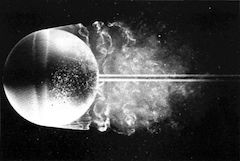Hands-on laboration
Flow Around Immersed Bodies
Flow Around Immersed Bodies
 In this laboration you will do flow measurements using a simple open "wind tunnel". In order to be able to achieve the best possible conditions, one would need a big and expensive closed wind tunnel. It is, however, possible to achieve conditions good enough for this laboration using an open simple "wind tunnel" - an axial fan attached to a duct with circular cross section. Inside of the duct, guide vanes have been installed that breaks down vortical flow structures generated by the fan. At the end of the duct the area is reduced by adding a convergent nozzle. The nozzle increases the flow velocity and makes the velocity profile more uniform.
In this laboration you will do flow measurements using a simple open "wind tunnel". In order to be able to achieve the best possible conditions, one would need a big and expensive closed wind tunnel. It is, however, possible to achieve conditions good enough for this laboration using an open simple "wind tunnel" - an axial fan attached to a duct with circular cross section. Inside of the duct, guide vanes have been installed that breaks down vortical flow structures generated by the fan. At the end of the duct the area is reduced by adding a convergent nozzle. The nozzle increases the flow velocity and makes the velocity profile more uniform.
Objectives
- Understand how shape and surface roughness affects the forces on a body immersed in a flow
- Determine forces using model experiments
- Understand the concept of separation and what causes it to appear
- Study the pressure distribution around a cylinder and along a wing profile
Outline
The laboration is divided into three parts:
- Part I: Drag Measurements
Determine the drag for a number of axisymmetric bodies and cylinders. Investigate the effects of surface roughness and body shape on arising forces. Explain the differences. - Part II: Measurement of Forces on a Wing Profile
Investigate how the drag and lift of a wing profile is affected by the angle of attack. - Part III: Pressure Measurements
Investigate how the static pressure varies around a cylinder and along a wing profile. Determine the pressure drag of a cylinder using the pressure measurements.
| Document Archive | |
| MTF053_LabPM.pdf | hands-on laboration instructions |
| MTF053_C05.pdf | lecture notes (chapter 5) |
| MTF053_C07.pdf | lecture notes (chapter 7) |
| MTF053_Formulas-Tables-and-Graphs.pdf | formulas, tables, and graphs |
| MTF053_Dimensional-Analysis-and-Similarity.pdf | dimensional analysis and similarity - complementary course material |